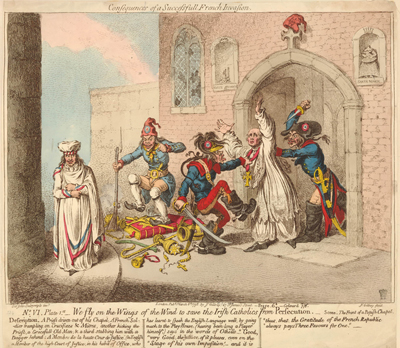Consequences of a Successful French Invasion, No 6. Plate 1st
We fly on the Wings of the Wind to save the Irish Catholics from Persecution.
This print is part of a 20 plate series—10 Numbers of 2 Plates each—described in a Pamphlet by Sir John Dalrymple and drawn and etched by Gillray, warning about the consequences of a French invasion. For more information about the genesis, background, and other plates in the series, see my Introduction to the Consequences of a Successful French Invasion.
Only four of the projected 20 prints described in the Pamphlet were completed before the project collapsed. Gillray seems to have worked on those four prints as the spirit moved him, so although he largely followed the plan set out by Dalrymple, he did not proceed consecutively.
We fly on the Wings of the Wind to save the Irish Catholics from Persecution was intended to be the 1st Plate of the 6th Number of the series. According to Dalrymple's hastily drafted plan, the scene for the plate was set in "The Front of the Parliament House of Dublin." But this is almost certainly a mistake by either Dalrymple or his printer. Since the second Plate of Number 6 (set in "St Paul's Church-Yard") is also about the desecration of religion, the setting described on the published Plate, "The Front of a Popish Chapel" is no doubt what was always intended.
The Description of this Plate in Dalrymple's original Pamphlet was unusually brief, but describes most of the basic elements of the published print:
A French Soldier trampling on Crucifixes and Mitres, another kicking a Priest, and a third stabbing him with a Dagger behind.

© Trustees of the British Museum
But I suspect that the Description appeared so short (especially in comparison to the other three completed Plates) that Dalrymple felt obliged to add some filler. The result is that we get an additional figure, a Member of the high Court of Justice in his official robes, observing and approving the scene, which suggests that the destruction of religion is not simply the work of a few cruel and renegade soldiers, but a sanctioned policy of the Directorate. But having introduced the Member, Dalrymple (or Gillray) has him quote from Othello, which in turn requires the increasingly ridiculous explanation of his knowledge of English and his background as a player, none of which can be expressed visually.
There are at least two preliminary sketches for this print which have come up for sale recently. One was listed on artnet. The other was part of Lord Jeffrey Archer's collection which was auctioned off to raise money for educational charities. Apart from the greater finish and careful coloring that characterizes the print, both drawings differ from the print in showing a skull and crossbones over the church arch instead of a bonnet rouge on top of the cross. With that detail, the print reinforces the message carried on throughout the design (and seen in other prints by Gillray) that the Revolution aims to destroy traditional Christianity and replace it with its own ideology.
Sources and Reading
- Commentary from the British Museum on Consequences of a Successful French Invasion, No 6. Plate 1st.
- Draper Hill, Mr. Gillray The Caricaturist, 1965, Chapter 7: A Patriotic Venture.
- "Sir John Dalrymple, 4th Baronet," Wikipedia
- Consequences of the French Invasion, a pamphlet by Sir John Dalrymple
- Thomas Wright and R.H. Evans, Historical and Descriptive Account of the Caricatures of James Gillray #178
- Thomas Wright and Joseph Grego, The Works of James Gillray, the Caricaturist; With the History of His Life and Times p. 236
Comments & Corrections
NOTE: Comments and/or corrections are always appreciated. To make that easier, I have included a form below that you can use. I promise never to share any of the info provided without your express permission.